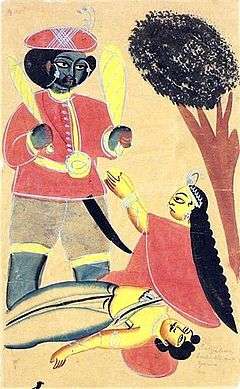Savitri Brata
| Savitri Vrata | |
|---|---|
 Savitri begs Yama for Satyavan's life. | |
| Also called | Savitri Osha |
| Observed by | Odia people, Maithil women[1] |
| Date | Jyeshtha (month) Amavasya |
| 2017 date | 25 May |
| 2018 date | 15 may |
| Related to | Savitri and Satyavan |
Savitri Vrata (Devnagari:सावित्री ब्रत), (Odia: ସାବିତ୍ରୀ ଓଷା or ସାବିତ୍ରୀ ବ୍ରତ) or Savitri Amavasya (Odia: ସାବିତ୍ରୀ ଅମାବାସ୍ୟା) is a fasting day observed by married Hindu Odia women of Odisha, India and Hindu Maithil women of Mithila region of India and Nepal on the Amavasya, the no moon day in month of Jyeshtha. It is also known as Sabitri Uwaans in Western Odisha region.[2]
Married Hindu women whose husbands are alive observe it as a vow with great dedication, and pray for their husband to have a long life. The word reflects the origin and significance of the Vat-Savitri puja. The fast is dedicated to Savitri, who saved her husband Satyavan from being taken by the death god.
The same festival is observed on Vat Purnima, the full moon of Jyestha in other regions including Maharashtra, Goa, Gujarat, Karnataka.
Legend behind the festival
The vrata was named after Savitri, the beautiful daughter of King Aswapati of Madra Desa. She selected Satyavan, a prince in exile who was living in the forest with his blind father Dyumatsen, as her life partner. She left the palace and lived with her husband and the in-laws in the forest. As a devoted wife and daughter-in-law, she went to great lengths to take care of them. One day while cutting wood in the jungle, Satyavan's head reeled and he fell down from a tree. Then Yama, the death God, appeared to take away Satyavan's soul. Deeply hurt, Savitri pleaded to Yamraj not to be separated from her husband. If anything, he would take away the soul of her husband and she would also follow. Yamraj, moved by the devotion of Savitri, returned the life of her husband. Soon Satyavan regained his lost kingdom.
Customs and rituals
All Hindu women observe this festival by worshiping and propitiating Savitri as a Devi.[3] In the early morning, women take purifying baths, wear new clothes and bangles, and apply vermilion to their foreheads. Nine types of fruits and nine types of flowers are offered to the Goddess. Wet pulses, rice, mangos, jackfruits, palm fruits, kendu, bananas and several other fruits are offered as Bhoga (offering) and observe the festival with Savitri brata katha. After fasting for the whole day, the fasting is over and the women have the Bhogal. In the afternoon, when formalities of worship are over, they bow to their husbands and elderly people.[4]
See also
References
- ↑ "Nepali women gathers in Mithila for Satisabitri Brata".
- ↑ "Savitri Brata Fasting in Orissa – Savithri Amavasi Utshav". www.hindu-blog.com. Retrieved 3 October 2016.
- ↑ "sabitri brata Poem" (PDF). odia.org. Retrieved 3 October 2016.
- ↑ "OdiaPortal.IN: How Women of Odisha Celebrates — Savitri Brata, Significance & Legend Behind this Festival". odiaportal.in. Retrieved 3 October 2016.
